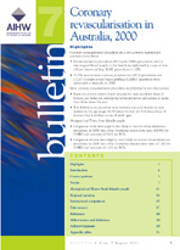Summary
Coronary revascularisation procedures are a very common treatment for coronary artery disease
- Revascularisation procedures (PCI and CABG procedures used to restore good blood supply to the heart) are performed at a rate of over 100 per day-totalling 38,901 procedures in 2000.
- 21,784 percutaneous coronary intervention (PCI) procedures and 17,117 coronary artery bypass grafting (CABG) operations were performed in Australia in 2000.
More coronary revascularisation procedures are performed in men than women
- Rates of coronary events (heart attacks) for men are twice those of women, yet males are undergoing revascularisation procedures at more than three times the rate.
- The difference in procedure rates between men and women is most marked in the age range 35-59 (rates for men are 5-8 times those of women) but is evident across all adult ages.
Aboriginal and Torres Strait Islander people
- Indigenous males were slightly less likely to receive revascularisation procedures in 2000 than other Australian males (rate ratio of 0.9:1 for CABG and rate ratio of 0.6:1 for PCI).
- Indigenous females were slightly more likely to receive revascularisation procedures in 2000 than other Australian females (rate ratio of 1.5:1 for CABG and rate ratio of 1.2:1 for PCI).
- In interpreting the previous points, it should be noted that Indigenous Australians have higher levels of cardiovascular disease (ABS 2002) and died from coronary heart disease at around twice the rate of other Australians in 1996–98 (AIHW 2001).
Volume of procedures per hospital
- Although there has been a sevenfold increase in the number of private hospitals performing PCI procedures during the 1990s, private hospitals tend to do only a small volume of procedures (11 out of 23 private hospitals were doing less than 100 procedures during 2000) in comparison with public hospitals.
Trends show that…
- Since 1993–94, age-standardised coronary revascularisation rates have increased by 30% overall—34% for women and 28% for men.
- During the same period, PCI rates have doubled for men and women, and CABG rates have declined by 12% for men and 11% for women.
- The increasing use of revascularisation may have several explanations. These include the ageing of the population, the increasing number of institutions catering for these procedures, advancements in techniques, the need for repeat procedures and the expansion in the range of indications for these procedures.
Australia has higher procedure rates than many OECD countries
- Australia ranks towards the higher end of the procedure rates for both PCI and CABG. These high rates are consistent with the relatively high age-standardised rates of coronary events in Australia.
Introduction
Current patterns
Trends
Aboriginal and Torres Strait Islander people
Regional variation
International comparisons
Data sources
End matter: References; Abbreviations and definitions; Acknowledgments; Appendix tables



